
Oh yeah, trains don’t run as frequently on Sundays in Germany! With eight minutes to spare before I can travel from Bornheim Mitte to the Hauptbahnhof, I suppose this is as good a time as any to pull out the computer and start writing. My original plan was to be out earlier for a trip down to Worms, but plans changed because it is 9:30 already, and I’m meeting family for dinner later today. So the idea now is to get to the main train station (Hauptbahnhof) and see what train might be leaving the soonest with no transfers along the route so I can minimize my travel time today while maximizing sightseeing opportunities.
The city, like all cities in Germany, is quiet on a Sunday. People get a late start and walk over to their local bakery to fetch breakfast that they’ll carry home. Before I got out, I was reading noisy American news about UFOs, how TikTok helped create chaos in Huntington Beach, yellow stars of David with “Unvaccinated” printed on them, and how gun sales are still up. What a bunch of crap to drive anxiety.
This got me thinking about the environment I’m in and how impossible it is to consider the German population could be riled into believing that imminent disaster is so close at hand that the only solution is to go buy more guns and ammunition. I’ll be the first to admit that in America, this doesn’t seem so absurd because guns are ubiquitous, but here I am in Europe, thinking of the population racing to knife shops and exhausting their supply of sharp new blades and the tools to keep them that way is simply bizarre. The idea that your fellow citizens or government is so unhinged that the apocalypse is never far away can only be seen as something approaching insanity.
Worms didn’t work out. I’m now on my way to Marburg to see whatever it is that might be in Marburg. Small and medium-sized cities and various train stops are interspersed between farmlands on the way north. It’s difficult snagging a photo (see above) as I’m on the sunny side of the train with a lot of glare off my window while the other side of the train is nearly full, as though the other passengers already knew where the hot side was.
Two stops so far in the first 40 minutes of my journey: first in Friedberg and then in Giessen. The next stop must be my destination. Our train grew shorter in Giessen as a part of it that was going to Siegen has been left behind.

The Marburg train station is on my right while the old town is on my left, but standing on the bridge crossing the Lahn River looking out in this direction, I try to imagine when this was an important trade route at the crossroads between Prague, Cologne, Italy, and the North Sea. With just forest and river in my view, there’s no hint of modernity; it’s easy to see the same thing someone else would have seen 400 years ago from this place on the map.

Here I am, about to delve into history, when a small sticker on a metal post catches my eye. I wonder where I join this group of slugs against slut-shaming?
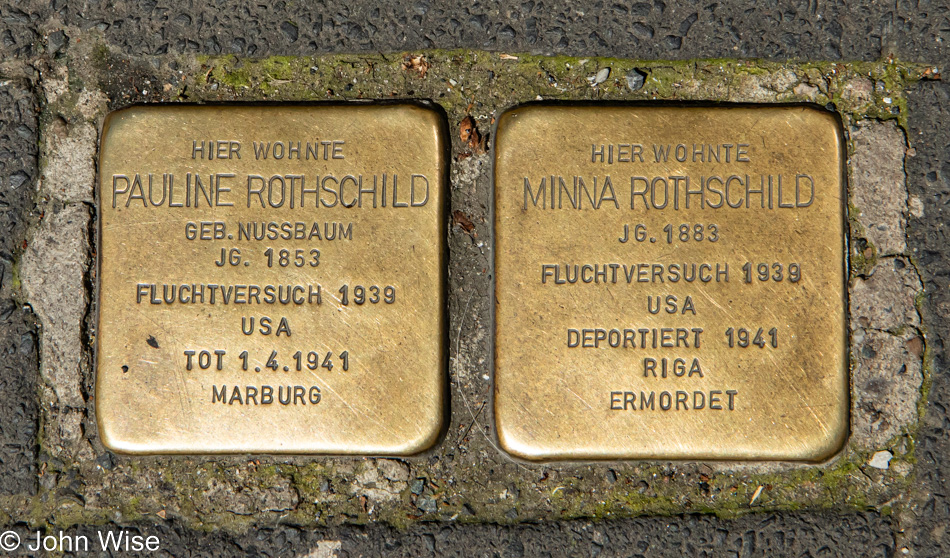
Mother Pauline Rothschild, age 88, when she died in Marburg, and probably her daughter Minna Rothschild, age 58, tried to escape to America in 1939, but by 1941, Pauline was likely murdered on the spot due to her age while her daughter was sent to Riga, Germany (now Latvia) probably as a slave until she too died at the hands of a rage-filled sociopath. These “Stumbling Stones” seem to be everywhere reminding us of the Jewish people who once lived in the house in front of which the stones are placed.

Saint Elizabeth’s Church of Marburg is my first stop after leaving the train station. This church was built between 1235 and 1283 over the gravesite of St. Elizabeth, wife of Count Ludwig IV of Thuringia. Her husband died while she was only 21. She had three children already and left the court of the Wartburg in Eisenach to live in poverty here in Marburg. This is also the first church in Germany built in the Gothic style and influenced by churches in Amiens and Reims, France.
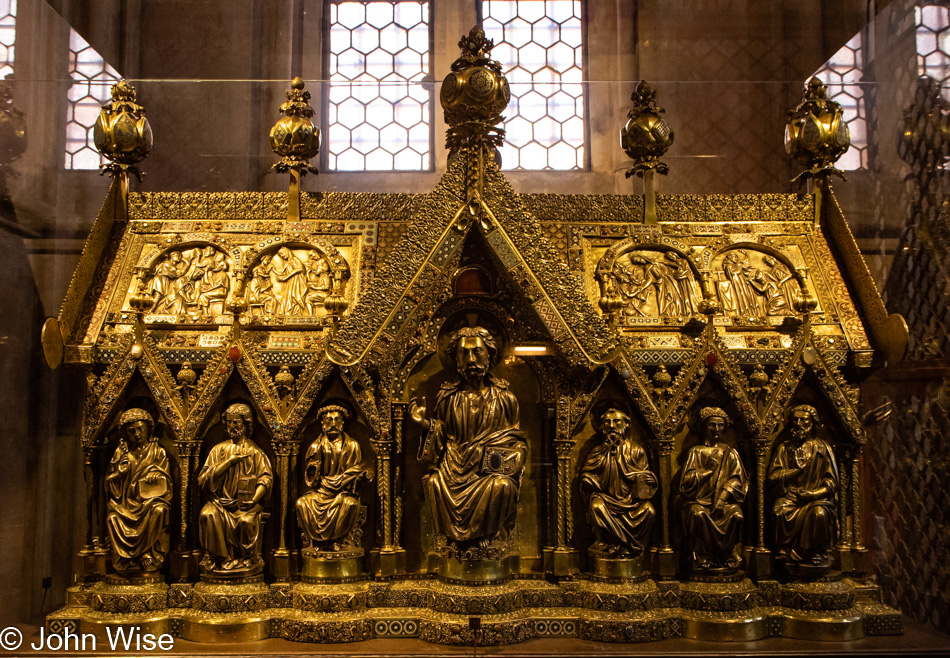
While a small pamphlet explains briefly a number of things in the church, not all are, such as this jewel-encrusted Shrine for St Elizabeth of Hungary made between 1235 and 1249.
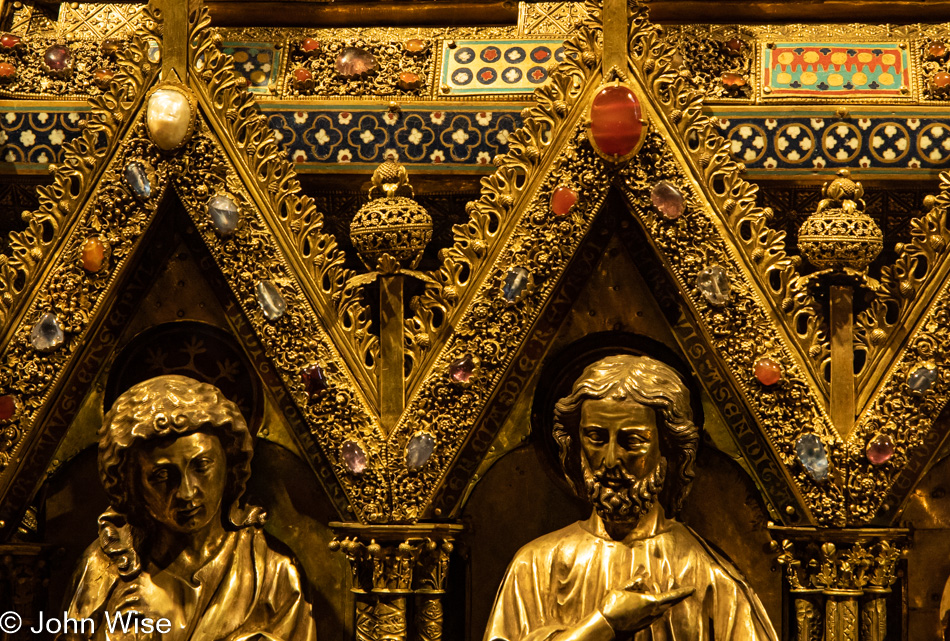
Close-up detail from the shrine.
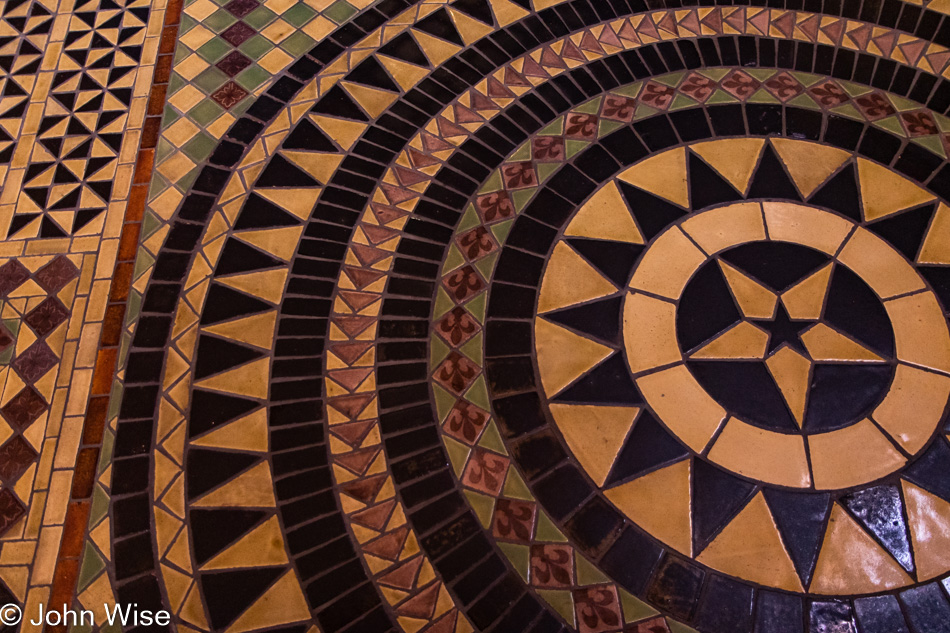
Remember when real work went into making floors, and we had these amazing designs in our kitchens? Yeah, me neither.
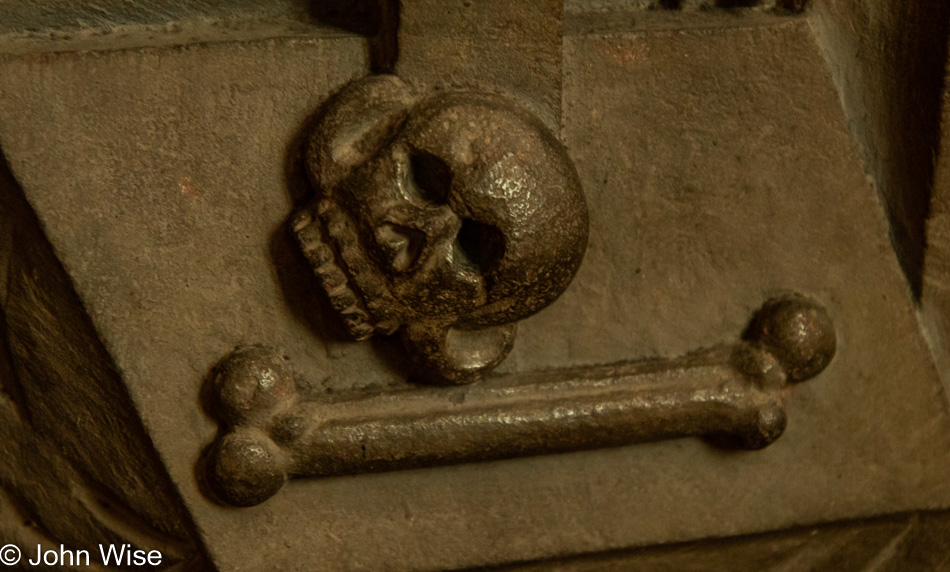
Maybe I’ve not been in enough American churches, but a theme I’ve often seen across Europe is the depiction of death.

These photos are in sequence with how I shot them, so at this moment, I was behind the altar and spotted this old graffiti in the dimly lit passage. Typically, these areas have been off-limits.
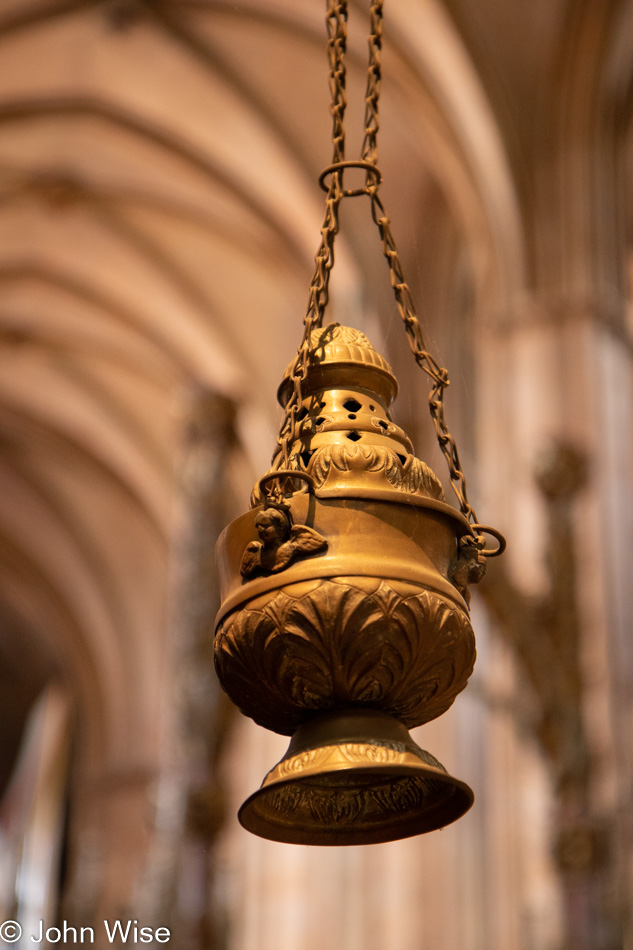
With nearly no one else in the church, it felt like I had a good long time to linger and check out the artifacts without feeling like I was blocking someone else from enjoying the sights.

I don’t know a thing about the landgraves entombed here but their final resting places are beautiful. In another section is the body of Paul von Hindenburg, who was the former President of Germany prior to the rise of Hitler, and next to his tomb lays his wife.
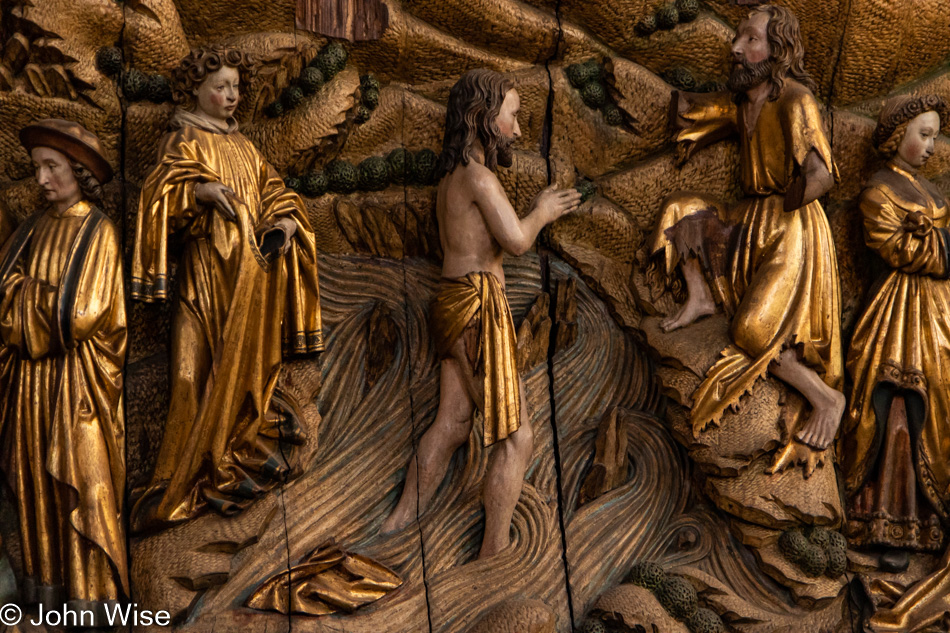
Church art must have been the blockbuster movies of their day. Only the church could have afforded such extravagances in the creation of pieces that would last centuries.
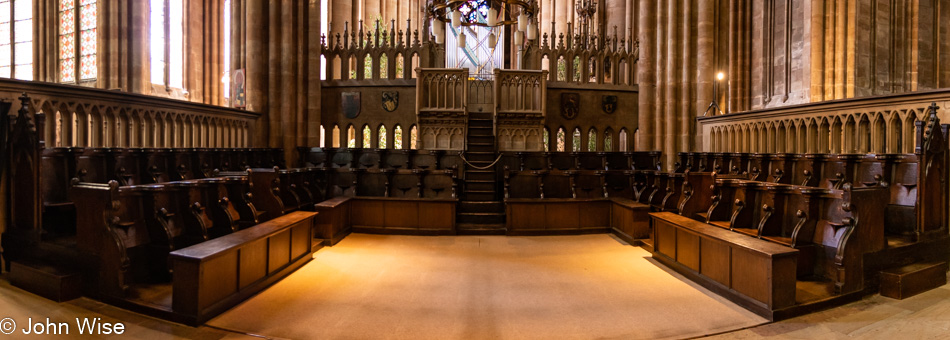
I’m sitting in the original oak choir stalls, which is where the Knights of the Teutonic Order also sat. While some visitors have come and gone, I’m mostly alone, save the person at the front door. My mask had to come down although it’s against government policy, I have to smell the church. The ambiance of these ancient buildings is not only the magnificence of what was built using primitive tools that required decades to finish, but not only the breadth of history they’ve witnessed but the scent of time that’s passed through these monuments.
While not a religious man, I can’t help but sit in quiet contemplation and listen for the echoes of God or for hints of the voices of those from the distant past that might still resonate within these walls. There is no organ playing, no incense burning, and only a few candles flicker here and there. How long might I have to wait here until what I believe is impossible continues to be denied me or that I give and leave?
Only the remains of the landgraves will linger on long after I’ve taken my leave, while no manner of deeds from myself will ever qualify me to lay in rest for potentially hundreds or maybe thousands of years as do those enshrined here. Is it only in death that we are afforded the privilege of hearing the voice of God?

The High Altar is the original and dates from 1290. Much to my surprise, I was allowed to walk behind it.
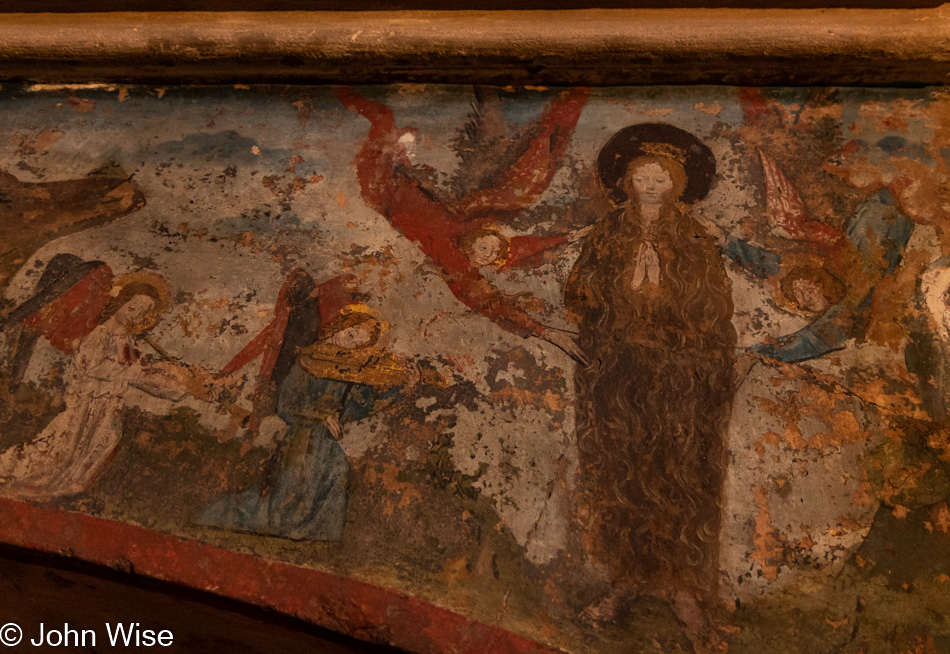
There’s no one here to tell me if the paintings on walls within the church are originals or if they are fading relics of something only painted in the last 100 years or so.
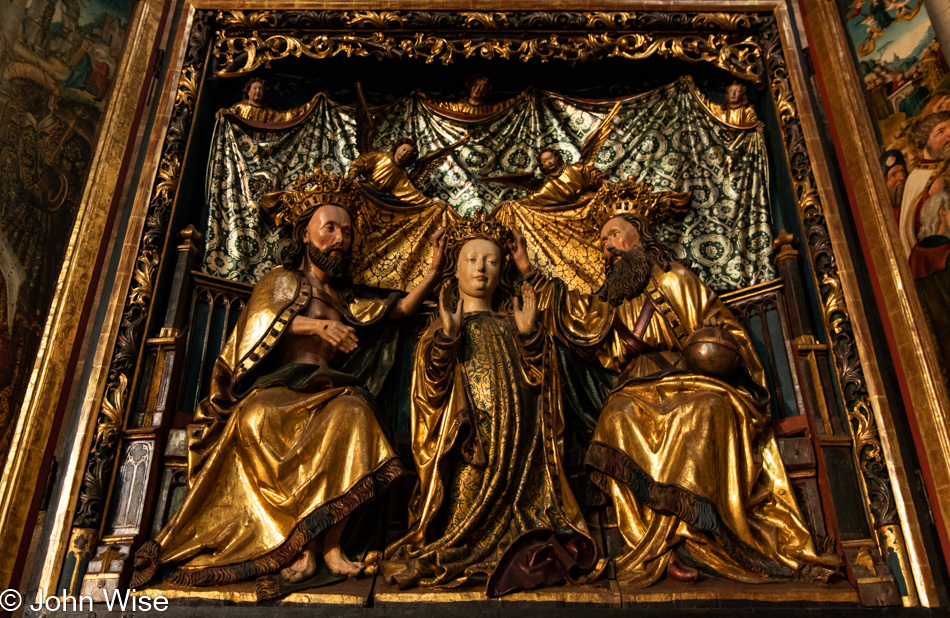
I spent a good long time here at the church, and, as usual, I never feel that I’ve given myself enough opportunity to simply be here and allow something I cannot seem to find or connect with to find me. I suppose giving into faith might be a needed first step, but that’s a line I’m not willing to cross.

Not an easy church to photograph from the outside as the usual culprits such as modern buildings and street signage, often obscure the views. In order to capture this much of the building, I had to cut off the lower part, including the doors, but you get the general idea.
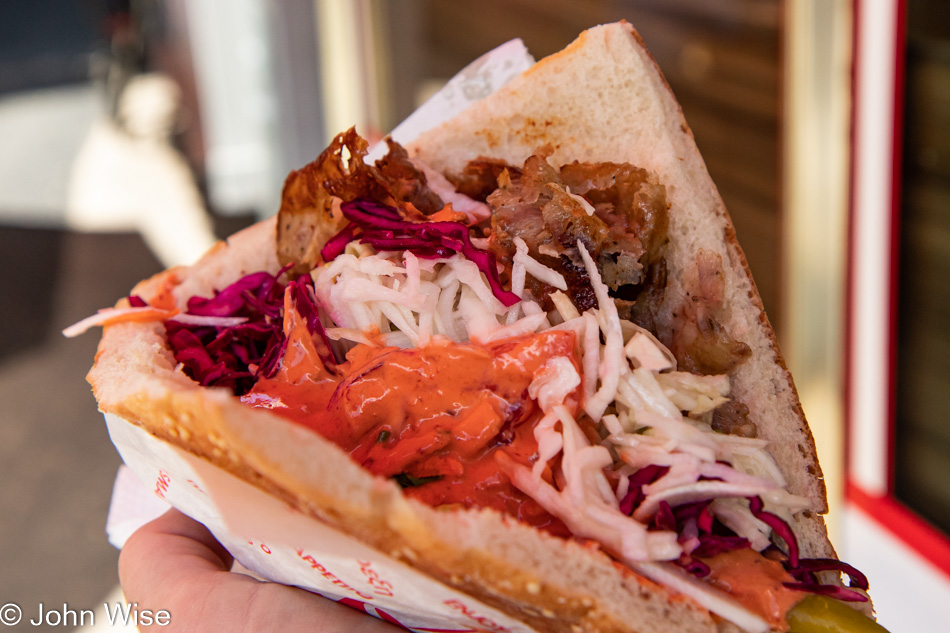
I never get food photography right, but that doesn’t mean I won’t post an image of it from time to time. Something as amazing as the good old Döner Kebab should be noted for posterity as we have nothing in America that comes remotely close to this incredible meal, and I miss them every time I return to the United States.
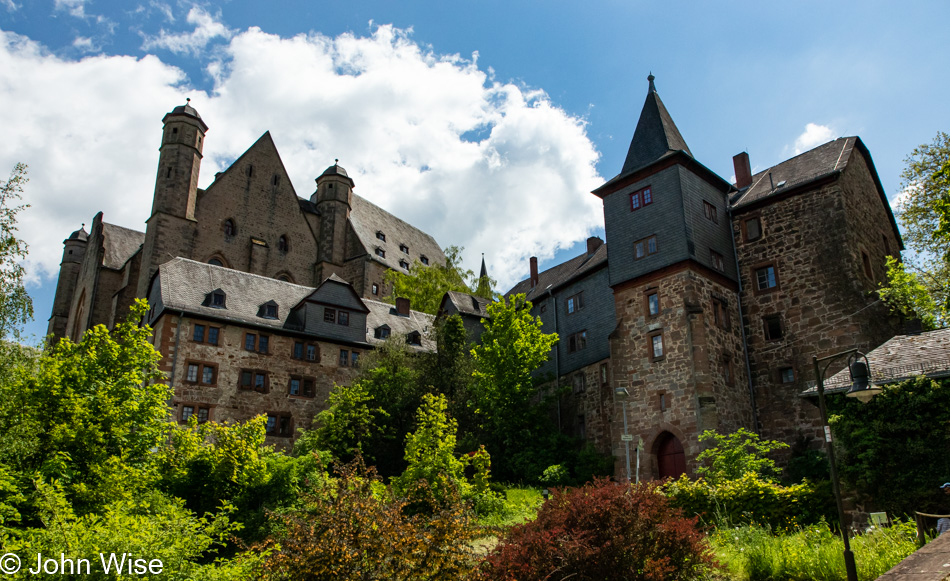
Just up the hill, or is it a mountain? This is the Marburg Castle. I don’t know how many of the 43 floors my Fitbit is reporting I’ve climbed, but it was a good, steep walk. I didn’t investigate whether any parts other than the exterior of the castle are visitable as if it were I’m certain Caroline would like to explore it with me. With the pandemic, I can’t believe it would be open yet, as there are so many restrictions still in place. No matter, it’s a nice walk.

Empty historical locations on a weekend are unknown to me. If only I could visit Florence, Italy, right now, but no way in 1,000 years would I go there without you-know-who.

While I’ve been somewhat manipulative, waiting for the few people who are here and there to clear away, that wouldn’t have been possible before the pandemic.

I can’t write much of what shows up in these blog posts in real-time, so here I am at 4:00 in the afternoon, 26 hours after I took the photo of the clock on the castle in Marburg. I’m sitting at Coffee Fellows between Hauptwache to my right and Alte Oper to my left. I’m having an oat milk two-shot latte, trying to stop people watching long enough to come up with something to add to my visit to the Landgrafenschloss (Landgraven Castle).

Back in the 11th century, the castle began life as a fort; the view should explain all you need to figure out its strategic advantage.
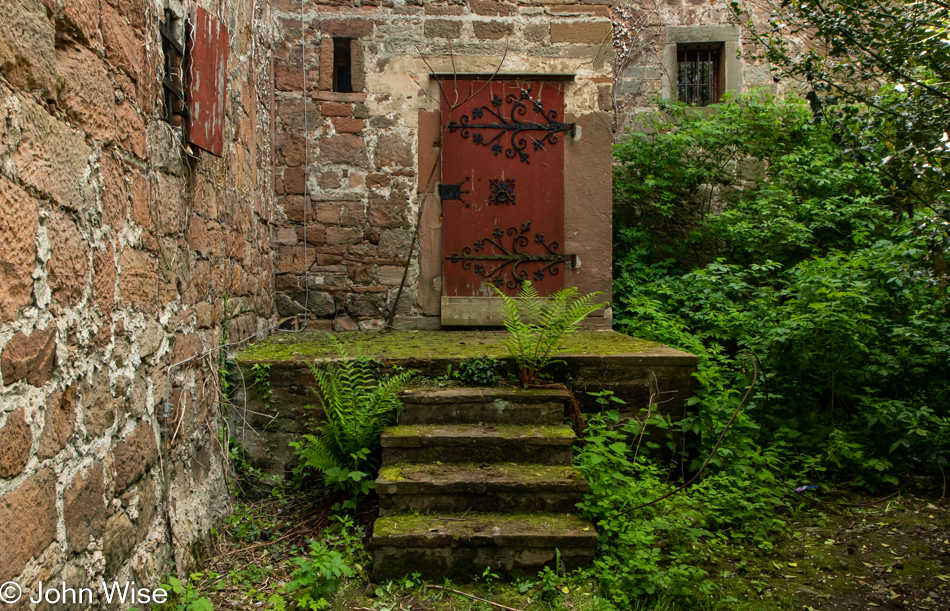
Decaying bricks and moss-covered stairs leading into a mystery beyond the door drew my imagination into wanting to discover what I might find in there. The intrigue is likely more interesting than the reality as all too often I’ve peered into dirty windows to find that I’m looking at junk as the space is being used for storage.

Ad infinitum, I reference the importance of capturing some of the smallest details to fill the gaps between the larger views. This should be of no consequence requiring explanation, but when I have nothing meaningful to add to an image, thus causing a minor amount of anxiety that I must write something, I likely repeat myself just so some dumb words show up that offer the reader really nothing at all. My apologies for wasting your time; I should have just posted the photo and said nothing.
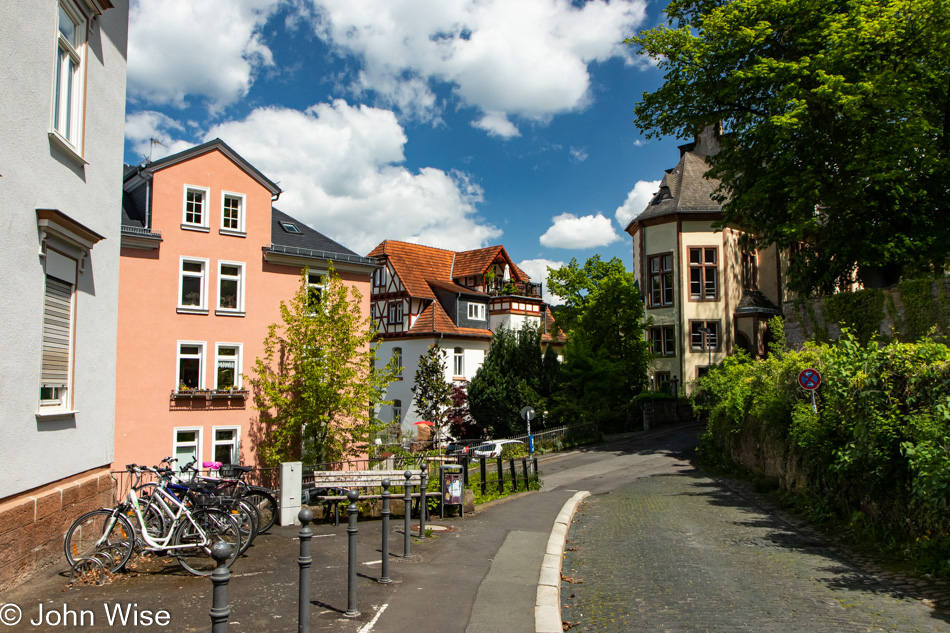
Somehow, I’d forgotten to get a coffee earlier, and with my head a bit sensitive for the transgression, I was able to pick up one “to go” from a small shop with a wide-open facade that didn’t have a line at the door to meter the people coming in. With coffee in hand, I was able to find a narrow wooden bench that won the 2019 Most Uncomfortable Award in Marburg for the second year running. I’m sure if COVID hadn’t hit last year, it would have been a triple play. Like every day, I have a complaint. Back in 1985, it cost me about $0.20 to $0.33 to use a toilet; today, it’s about $1.10. My coffee costs just over two bucks, and it costs another dollar to get rid of it. This is demotivating for my attitude of staying hydrated. No wonder Germans go out to the bakery, grocery, or ice cream shop and then right back home; otherwise, they’d go broke keeping their bladders empty.
I need to head to the train station as my ride back to Frankfurt leaves in 25 minutes, but first, I need to go throw away a Euro.

Back on the train questioning if this $35 roundtrip journey was worth it. This is an important question as I have other regional treks planned that will cost a similar amount. I think the value I assign to a place is related to the quality of photos, the story I stumble into after reflecting on the day, and some other unknown intrinsic values I’m not aware of yet.
Hmm, Katharina just posted to the Engelhardt / Wise WhatsApp channel that her train is about 15 minutes late, while mine is now 11 minutes late. We are supposed to converge in Heddenheim around 5:00 as Klaus is making us Grüne Sosse, and I do believe I could eat Grüne Sosse every day.
Due to it being Sunday, I feel it’s okay to feel less than productive. I won’t be seeing Jutta this afternoon, but I’ve seen her every other day I’ve been in Germany, so that’s not so bad. Being lazy on occasion isn’t a negative, though I do feel guilty as here I am exploring the German countryside while Caroline just started her Sunday in the heat of the desert. While it’s 7:00 in the morning in Phoenix, I have 4:00 in the afternoon here. We’ll try to get in as much long-distance affection in the next seven hours as possible, as after that, I’ll disappear for nearly eight hours, and upon waking, Caroline will be short upon going to sleep herself.
We are passing through Giessen, and from its appearance, I can’t say that anything looks particularly interesting, nor do I remember hearing about anything that must be seen. By the way, I’m looking at Germany with such a critical eye because if one day we were to move back here, this would be our reality. I think I’ve had a Pollyannaesque view of Germany, and my idealism overwhelmed the reality that people must live in functional, affordable housing with plenty of jobs to support them as opposed to quaint and idyllic locations where a kind of Disneyland abundance of fun awaits me. There is a utility to much of what’s plopped down along the train tracks and beyond the farms. Small plots of new-growth forest are off in the distance but little in the way of wildlands.
Maybe I’m on to something in way of explaining the trappings of life in Germany with so many coffee shops, bookstores, museums, and at other times, a ton of events; you grow up here knowing the conformity and lack of diversity, and so on long vacations you must go far away. You take your bike to some faraway mountains and take a ride in a manicured forest because the wild ones don’t exist here. Getting in the car to take a long drive will result in the stress of needing to drive competitively using expensive gas to arrive somewhere that might be quite like the place you left. If you are going to spend $8 a gallon for gas to travel the 700 miles roundtrip from Frankfurt to Berlin, costing you $160 compared to a similar trip in America that costs about $65, maybe you are not so inclined to call that a day trip, and you need to distribute the high cost across a couple of days?
In the western United States, we have the luxury of driving a relatively short distance to go from desert to forest or to the sea, even if you are living in Phoenix and want to visit the Pacific Ocean or head into the San Juan Mountains of southwestern Colorado. Now, I have to wonder if I’ve taken that convenience for granted. This is a tough question at this time, as the previous American political climate and fear-driven society turned me against the idea of being comfortable in such an incredibly beautiful country. Combined with our social and economic inequity, it feels as though we are building a powder keg looking for a spark.
We passed through Dortelweil. Is it like Bielefeld, or is it like Tucson at the edge of the universe? Two hundred years ago, there were only 448 people living in Dortelweil; a hundred-fifty years after that, in 1960, there were 1,690 people. Today, there are more than 7,000, which likely means it’s a suburb of Frankfurt with many residents making the commute into the city. There wasn’t really a valid reason to offer this information, but I was passing through and thought that Dortelweil might need an occasional nod to its existence compared to its powerhouse neighbor down the train track.

Got into Frankfurt to another glorious afternoon, and as quickly as I arrived, I was on my way to Heddenheim to meet with Katharina, Klaus, and Stephanie for dinner. I’m serious about this potential ability to eat Grüne Sosse every day. Somehow, I forgot to take even one photograph of anything while I was visiting; I guess I was content to hang out, chat, and laugh.

Tomorrow will arrive early as we are moving some things to Jutta’s in the early morning, so I’m gonna rip through the few photos I shot today and try to find my eyes shut before midnight. For the record, this is St. Catherine’s Church or St. Katharinenkirche in German.